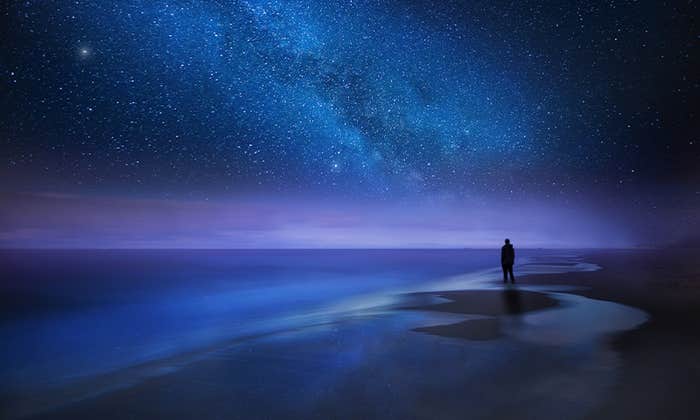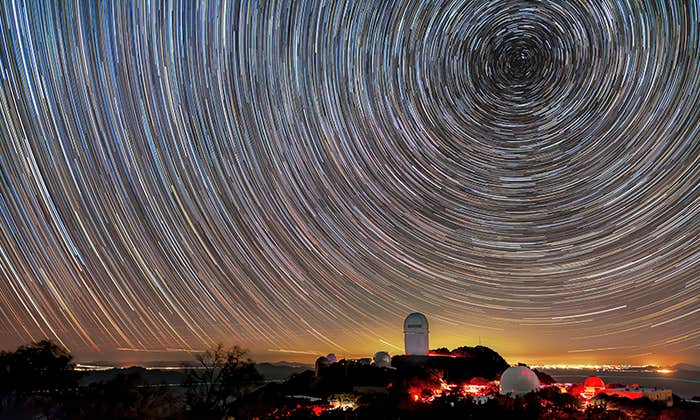Our solar system is on its way out. Slowly. Over the next several billion years, a series of unfortunate events will take place, spanning from the not-so-great to the truly tragic. Afterward, our solar system will be gone: All of the planets will be lost and the sun will be a solitary white dwarf.
(Pause to wipe away tears.)
I will guide us through our solar system’s future, one step at a time. Since Earth is our home base, I’ll include a key event affecting life on Earth. Here are the five steps to come:
- 1. Earth’s oceans will boil off.
2. The rocky planets’ orbits may go unstable, leading to a potential giant collision between planets.
3. The sun will become a red giant and swallow the rocky planets.
4. A passing star will trigger a dynamical instability among the remaining planets.
5. A passing star will strip away the final planet.
It is a near certainty that each of these events will happen, with the exception of number 2 (which has only a relatively small probability). But it will take about 100 billion years to reach the end.
Let’s get to it.
The End of Liquid Water (and Life) on Earth
The sun is ever-so-slowly heating up. Today, it’s about 30 percent brighter than right after it formed. As the sun converts hydrogen to helium in its core, the mean molecular weight increases, thus increasing the core’s temperature and the rate of the fusion reaction (called the proton-proton chain). This slowly increases the sun’s energy output.
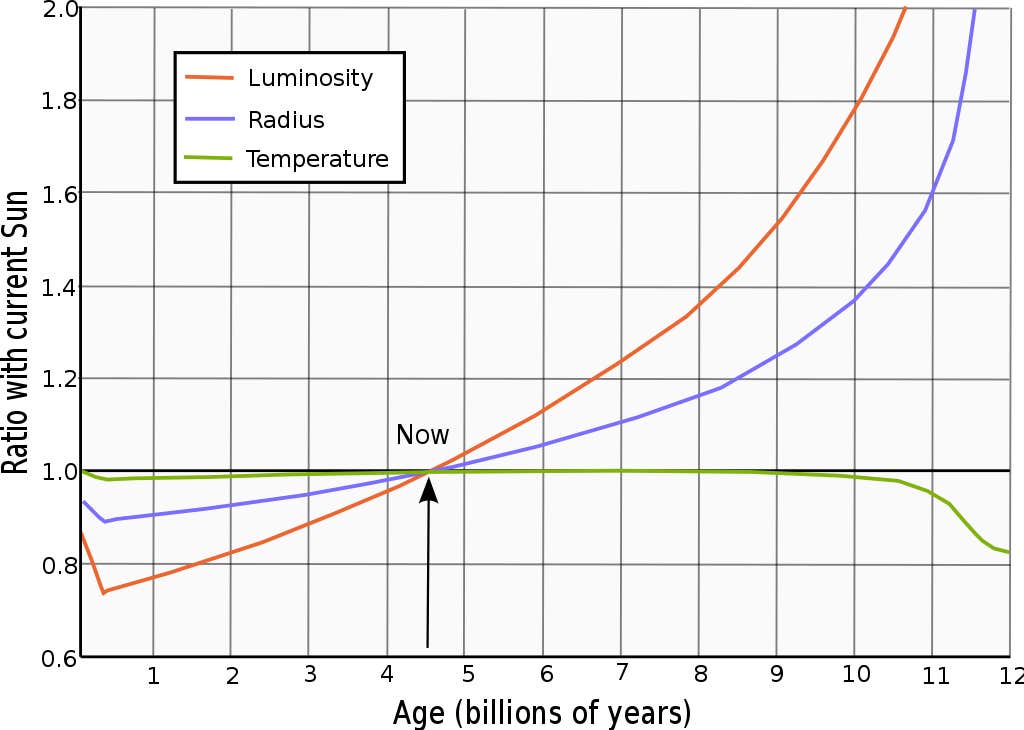
Life as we know it requires liquid water. In order to maintain liquid water on a planet’s surface, there must be a balance between the energy coming in and the energy going out that maintains the right temperature range.
The energy balance is always adjusting itself. If the amount of greenhouse gases in Earth’s atmosphere increases (as it is doing today), the “blanketing” effect of greenhouse gases creates a new energy balance with a hotter surface.
Earth does have a built-in thermostat: the carbonate-silicate cycle, which regulates the amount of carbon dioxide in the atmosphere, thus maintaining a stable climate. Unfortunately for us humans, it operates on about a million-year timescale so it is much too slow to help us with the current global warming problem.
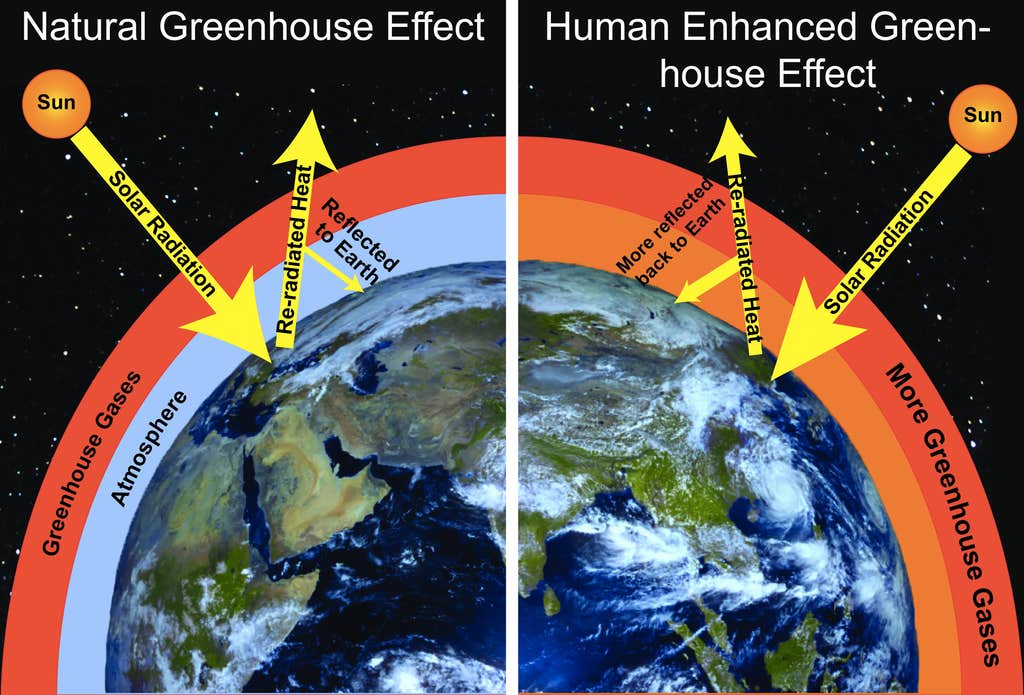
Another way for a planet to heat up is if the amount of incoming energy increases. This is exactly what is happening as the sun’s brightness slowly increases. And, although there are much shorter-term variations in Earth’s climate from seasons, changes in atmospheric composition (both from human-made greenhouse gases and sometimes from volcanic dust), and Milankovitch cycles, Earth’s surface is slowly but inexorably heating up due to the increasing solar brightness.
At some point, Earth’s atmosphere will no longer be able to maintain a stable energy balance and the greenhouse heating will enter a runaway phase. In a runaway greenhouse, there is a positive feedback loop. The planet’s surface becomes hotter, which causes more water to evaporate into the atmosphere. Water is a strong greenhouse gas, so this increases the strength of the greenhouse effect, which further heats the planet’s surface.

Once the greenhouse effect goes runaway, it will heat up Earth’s surface to the point that the oceans will entirely vaporize. This will just make the planet hotter and hotter until a new balance is reached, with a scorching hot surface and all of the water trapped in the atmosphere (likely in a “supercritical” state, meaning there is no distinction between liquid and gas). There will be more water vapor close to Earth’s surface but no liquid ocean.
Another way to think of this is in terms of the “habitable zone”—the region of orbits around a star inside which a planet can maintain liquid water, provided it has an appropriate atmosphere. The inner edge of the habitable zone is the distance from the star inside which a planet’s atmosphere will undergo runaway greenhouse heating. Right now, the inner edge of the sun’s habitable zone is at about 95 percent of the Earth-sun distance.

With the brightening sun, that inner edge of the habitable zone is slowly marching outward. Exactly when the inner edge of the habitable zone will cross Earth’s orbit is a little tricky to pinpoint, but estimates point to about a billion years from now.
From that point on, there won’t be any more liquid water on Earth. No more liquid water means no more life, at least as we know it. In the words of the great Mel Brooks: “There goes the planet!”
Chaotic Destabilization of the Rocky Planets’ Orbits
The planets’ orbits are chaotic. In a mathematical sense, this means that we cannot predict their exact positions in the distant future (beyond about 10 to 100 million years).
When thinking of the future, it’s easy to imagine the worst. When my kids were still crawling around, I would find myself imagining horrific futures in which they crawled off the edge of, well, anything tall. Luckily, nothing like that ever happened. But the prospect terrified me.
Given that the rocky planets’ orbits are chaotic, we cannot know their future. Should we just assume that their orbits will remain nice and stable for all time? Or, like a young parent, should we assume the worst, that things will somehow go terribly wrong?
Computers can help us find an answer, albeit a probabilistic one. Using codes designed to follow the orbits of the planets forward in time, we can simulate many possible futures for the solar system. Each simulation starts from very slightly different positions for the planets today, then projects those into the future. We know the positions of the planets quite accurately, but there are uncertainties at the level of millimeters to meters, and those uncertainties are magnified by chaos.
Some simulations find that Mercury’s orbit will become extremely stretched-out, or eccentric. This can happen if Mercury enters a “secular resonance” with Jupiter. The resonance causes an orbital alignment between the two planets in which the planets’ apsidal lines—the line connecting the sun to the position of closest approach—start to precess together, maintaining their alignment over many thousands of years. This acts to progressively stretch out Mercury’s orbit in dramatic fashion:

Once Mercury’s orbit becomes so stretched-out that it crosses the orbit of Venus, all sorts of crazy things can happen. Mercury can come so close to the sun that it is engulfed. Another possibility is that Mercury collides with Venus. Perhaps the most dramatic (and tragic) outcome seen to date is that it is possible for Mercury to end up perturbing the other rocky planets’ orbits to the point of triggering a collision between Earth and Mars, as you can see in this image:

What is the likelihood of this happening? Is Earth really going to collide with Mars in 3 billion years? The most rigorous study to date, from 2009, showed that there is about a 1 percent probability of Mercury entering the secular resonance with Jupiter and wreaking havoc in the next 5 billion years. Even if Mercury enters the resonance, there is only a small chance of a collision with Earth. It is much more likely that Mercury will simply fall into the sun or collide with Venus.
In other words, there is a 99 percent chance that the rocky planets’ orbits will continue to zoom around the sun like clockwork, at least until the sun itself starts to change …
The Sun Will Evolve Into a Red Giant, Swallow the Inner Planets, and Become a White Dwarf
In about 5 billion years, the sun’s core will run out of hydrogen, the fuel of its fusion reactor. The sun will continue to fuse hydrogen in an expanding shell, and this will puff the sun up into a red giant.
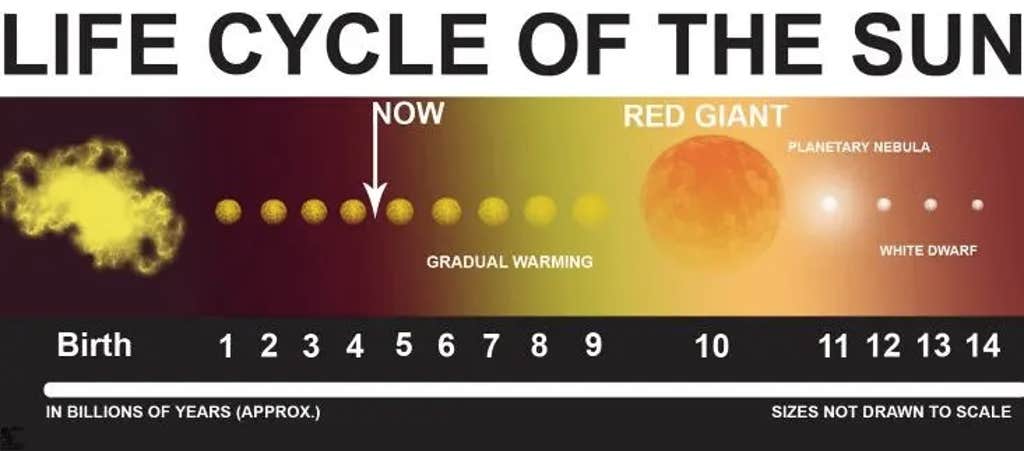
Betelgeuse, Orion’s bright right shoulder, is a good example of a red giant. The sun will be a red giant for about half a billion years. It’ll increase in brightness, shifting the habitable zone outward to encompass Jupiter and Saturn. During this phase, the giant planets’ large moons may have the conditions for liquid water on their surfaces. Many of those moons have a lot of water in their interiors, including some (most famously, Europa) with liquid oceans under icy shells. Ganymede, the solar system’s largest moon, has a mass about 40 times smaller than Earth, yet is thought to be about half water! That makes Ganymede’s water budget significantly larger than Earth’s, since our planet is only about 1 part water in 1000 by mass. Ganymede will make quite the ocean moon in about 7 billion years.

The planets’ orbits will adjust to the changing sun. The inner planets will be engulfed when the sun is a red giant. Planets far from the sun will expand onto wider orbits as the sun loses mass to powerful winds flowing out from its surface. As the sun’s gravity weakens, a planet’s orbit naturally widens, like a slinky losing its tension and stretching out with age.
Now, a red giant is big. The sun will expand by about a factor of 100 to become a red giant, and will extend out about as far as Earth’s current orbit. Our planet is at the brink: We don’t know whether it will be swallowed by the sun or escape onto a larger orbit.
Meanwhile, the sun’s core will contract until the increased temperature and pressure enable the fusion of helium. There will be a few flashes, then the sun will puff off its outer layers as a “planetary nebula” (which has nothing to do with planets—it’s just an old name that stuck around). What will remain of the sun is its core, a small white dwarf that does nothing but slowly cool off for eternity.

White dwarfs are almost as massive as the sun but only about the size of Earth. This gives them extremely strong surface gravities, and any material heavier than hydrogen or helium settles out of their atmospheres and into the stars themselves in days to months—an astronomical blink of the eye.
When we look at white dwarfs, a large fraction of them appear to be “polluted”: Instead of having pure hydrogen or helium spectra, their outer layers are contaminated with rocky (or sometimes ice-rich) material. Because it should settle out very quickly, this rocky material must have collided with the white dwarf quite recently.
White dwarfs might be polluted by a slow trickle of material falling onto their surfaces from disks of debris on very close orbits. The debris comes from small bodies that were gravitationally sling-shotted by the planets during and after their orbital shift. Since a white dwarf is a tiny target, small bodies do not crash into the star but instead are torn apart by its gravity, spinning out disks of rocks that are ground to dust as they orbit very close to the white dwarf.
In about 7 billion years, the sun will be a white dwarf. Earth will have either been swallowed by the red giant sun or just thoroughly roasted. Viewed by a distant observer, the only hint that a pale blue dot once orbited this dime-a-dozen white dwarf will be a few distinctive spectral lines—the blood spatter from a long-dead planetary system.
To this point, our story looks like this:

But this is not the end. Five (or maybe six, if Earth is lucky) planets will survive to see the sun as a white dwarf.
A Passing Star Triggers a Dynamical Instability Among the Planets
Nothing lasts forever (even cold November rain).
After the sun becomes a white dwarf, its planetary system will be almost twice its current size. Not in terms of the number of planets, of course (bye-bye, inner rocky planets), but in terms of the sizes of the surviving planets’ orbits. The sun will have lost about 40 percent of its mass, much of it going to create a beautiful planetary nebula on its way to becoming a white dwarf. The planets’ orbits will widen in response by about 85 percent. Neptune’s orbit will grow from 30 to about 55 astronomical units, marking the outer edge of the planets.
It should be just smooth sailing from here to eternity, right? The planets will be on nice, nearly circular orbits around a white dwarf. And that pesky inner, chaotic part of the solar system will have been swallowed by the sun.
Only one thing could possibly endanger the solar system now: other stars.
Stars only spend a lot of time close to each other when they’re babies. In their birth clusters, stars frequently pass relatively close to each other. (The exact number depends on the size and density of the birth cluster.) Sometimes stars pass so close that their gravity affects what’s in orbit around each star. For instance, a passing star can destabilize the very outermost parts of another star’s planet-forming disk. And in some cases, a passing star can even steal a very wide-orbit planet. (This is a possible origin for the hypothetical Planet 9.)
One model proposes that the orbits of very distant objects in the Kuiper belt were shaped early in solar system history, when a star came within a few hundred to a thousand astronomical units of the sun. (It’s a contentious model.) This is a typical distance for the closest encounter that a star like the sun would experience in a birth cluster like the sun’s. This encounter may even have been the closest encounter the sun ever underwent, at least from its birth to its becoming a white dwarf.
Once their birth clusters dissipate, stars generally stay far away from each other. This is just because space is really big. Given the density of stars in the sun’s neighborhood and how fast they move around, we can calculate the typical time it takes for a star to pass within a given distance of the sun. On average, another star passes within 10,000 astronomical units of the sun every 20 million years or so, within 1,000 astronomical units every billion years, and within 100 astronomical units every 100 billion years.
Let me describe a fantastic 2020 study by Jon Zink, Konstantin Batygin, and Fred Adams that really improved our understanding of the solar system’s far future. They performed 10 simulations of the solar system’s orbital evolution for a trillion years, starting from the present day and then following the planets as the sun becomes a red giant, then a white dwarf, and continues into the distant future. The Big Bang was only 14 billion years old, so Zink and colleagues’ simulations stretch to about 70 times the current age of the universe. Each simulation represents a possible future for the solar system. In this case, the futures differ mainly in terms of the passages of stars close to the sun and planets.
A planetary system is only strongly affected when a star passes very close-by, within three to five times the size of the largest planetary orbit. With Neptune at 30 astronomical units, a star would need to pass within about 100 astronomical units to have a strong impact on the present-day solar system. But with Neptune at 55 astronomical units around the white dwarf sun, a star passing within about 200 astronomical units will have a strong effect on the planets. Even a flyby at 500 astronomical units gives Neptune a noticeable gravitational kick.
In Zink and his colleagues’ simulations, within about 30 billion years, a star passed within a few hundred astronomical units, triggering a dynamical instability. This will be a much stronger instability than the one that happened early in solar system history, because it will include gravitational scattering between Jupiter and Saturn. Instead of relatively gentle spreading of the giant planets’ orbits, this will look like the dynamical instabilities that astrophysicists think are commonplace among systems of giant exoplanets (and that often destroy their rocky planets):
This dynamical instability will eject all of the remaining planets but one. The gravitational kicks between planets will give each planet (but one) enough orbital energy to be launched into interstellar space to become free-floating planets. In most of Zink’s simulations, Jupiter was the last planet standing, surviving on a stretched-out orbit similar to those of giant exoplanets.
From this point on, the solar system will consist simply of the white dwarf sun and Jupiter. This is fitting in an odd way because, if we were to search for solar systems around nearby sun-like stars using present-day technology, Jupiter is still the only solar system planet that could be detected (for now).
The Close Passage of a Star Strips Away the Sun’s Last Planet
Just like every rope has a breaking point, any planet can be stripped away from its star if another star passes close enough.
At this stage Jupiter, the solar system’s last planet standing, will be on a wide, stretched-out orbit.
Distant flybys of stars can gently nudge Jupiter toward ejection, but the effect of very rare, very close encounters is actually what dominates. Zink’s simulations need to wait about 100 billion years for a star to pass within about 200 astronomical units. The star gives Jupiter the gravitational energy it needs to escape from the white dwarf sun and never come back. (Zink’s simulations had a range in the timing of the ejection of the last planet standing, from about 40 billion years in the future to a little over 300.)
So here are what the last phases of the solar system’s lifetime will look like:

When all is said and done, five or six of the sun’s eight original planets will still be intact, just not in orbit around the sun. Those planets will survive as free-floating, or “rogue” planets (the other two or three having been swallowed during the red-giant phase). Of course, those planets won’t be alone: The abundance of free-floating planets will be constantly increasing, as many other stars lose their planets to interstellar space.
This marks the end of the solar system. Wraps it all up. I hope you’ve enjoyed its story. ![]()
Sean Raymond is an American astrophysicist working at the Bordeaux Astrophysical Laboratory in France. He also writes a blog at the interface of science and fiction (planetplanet.net), and recently published a book of astronomy poems.
Additional Resources
- The Solar System’s story (with links to all chapters)
- Reading Earth’s destiny in the blood spatter around white dwarf stars (Nautilus article)
- How Planets Die: Roasted, Toasted and Swallowed by their evolving stars (from the How Planets Die) series
- Second chance planets: Iceball worlds that thaw out when their stars go red giant (the positive spin from the How Planets Die series, including the ultimate Second-Chance Solar System!)
- Some key technical papers: Koparappu et al 2013 (habitable zone limits), Ramirez and Kaltenegger 2016 (habitable zones of evolving stars) Laskar and Gastineau 2009 (about the possibility for chaos-driven dynamical instability among the rocky planets in the next 5 billion years), Veras 2016 (about how planetary systems respond to their evolving stars, Zink et al 2020 (about late instability and loss of the planets from stellar encounters over 100 billion years).
- The MOJO videos (in case you want to see me blabbing about planet formation live).
Lead image: Naeblys / Shutterstock
Reprinted with permission from Sean Raymond’s blog PlanetPlanet.net.
























